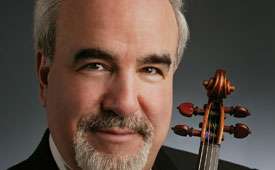|
Back
Females in Fiddles New York
Avery Fisher Hall, Lincoln Center
05/19/2012 - & May 22*, 2012
Antonín Dvorák: Carnival Overture, Op. 62
Béla Bartók: Violin Concerto No. 1, Op. Posth., BB48A
Peter Ilych Tchaikovsky: Symphony No. 4 in F minor, Op. 36
Glenn Dicterow (Violin)
New York Philharmonic Orchestra, Alan Gilbert (Conductor)

G. Dicterow (© Chris Lee)
Beethoven had his “Spring” Sonata, Schumann had his “Spring” Symphony. So here’s a proposal for a “Spring” concerto.
Like Alban Berg, Béla Bartók wrote a violin concerto for a presumably dazzling girl of his acquaintance when he was a 25-year-old stripling in Hungary. Both females were lost (Berg’s died, Bartók’s found another lover), but both concerti aimed to personify the females in their fiddles.
Berg’s concerto is one of the most acclaimed of the 20th Century. Bartók, alas, put his work aside, re-using one movement for another piece. But in 1958, 13 years after his death, it was resurrected, While performances are rare (I don’t remember any others in New York), this is a work which itself has a rare simplicity, a work which is obviously Bartókian, but enjoys the innocence, the breeze, the lilac-perfume of Spring.
No other resemblance will do.
This was the only work last night which I needed to hear, since the other two pieces–Dvorák’s Carnival and Tchaikovsky’s Fourth book ended the world premiere of Magnus Lindberg’s neo-romantic Piano Concerto last week. But Maestro Alan Gilbert did give such a whirlwind opening that it took a conscious change of mood to appreciate the verdant section, with English horn and clarinet in a bucolic interlude.
Just the interlude, in fact, to introduce Glenn Dicterow, the long-time concertmaster of the New York Philharmonic, as soloist in the Bartók. Mr. Dicterow, I have heard, is a rather self-effacing person, and the first movement performance was appropriately low-key, soft, subtle, Mr. Dicterow’s amber tones building up for the unexpected forte climax by the whole orchestra. (Even for a love song, Bartók was hardly loathe to use pairs of trumpets, trombones and French horns.)
This was pure atmosphere, definitely Bartók but simple Bartók. The second half was the “talking” Bartók. The girl must have had a multifarious personality, for Mr. Dicterow’s violin and Mr. Gilbert’s orchestra engaged in a dozen colloquies, with near-human intonation.
It must have been a joy for Bartók to paint the portrait, and Mr. Dicterow, one feels, had a joy in playing this evocation of youth, Pest, Buda, the Danube, and springtime enchantment.
Harry Rolnick
|